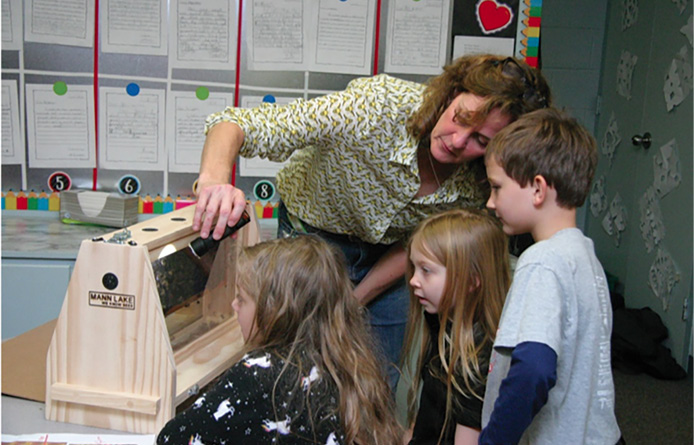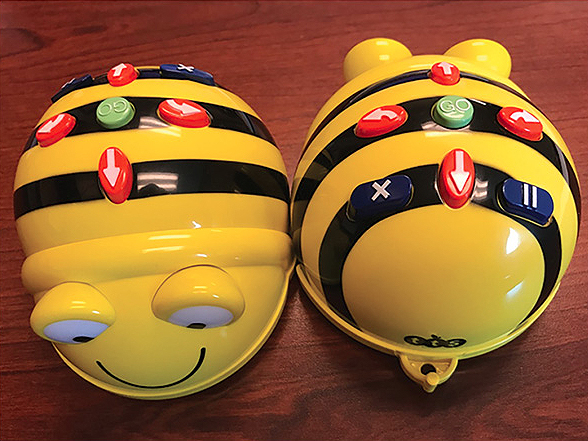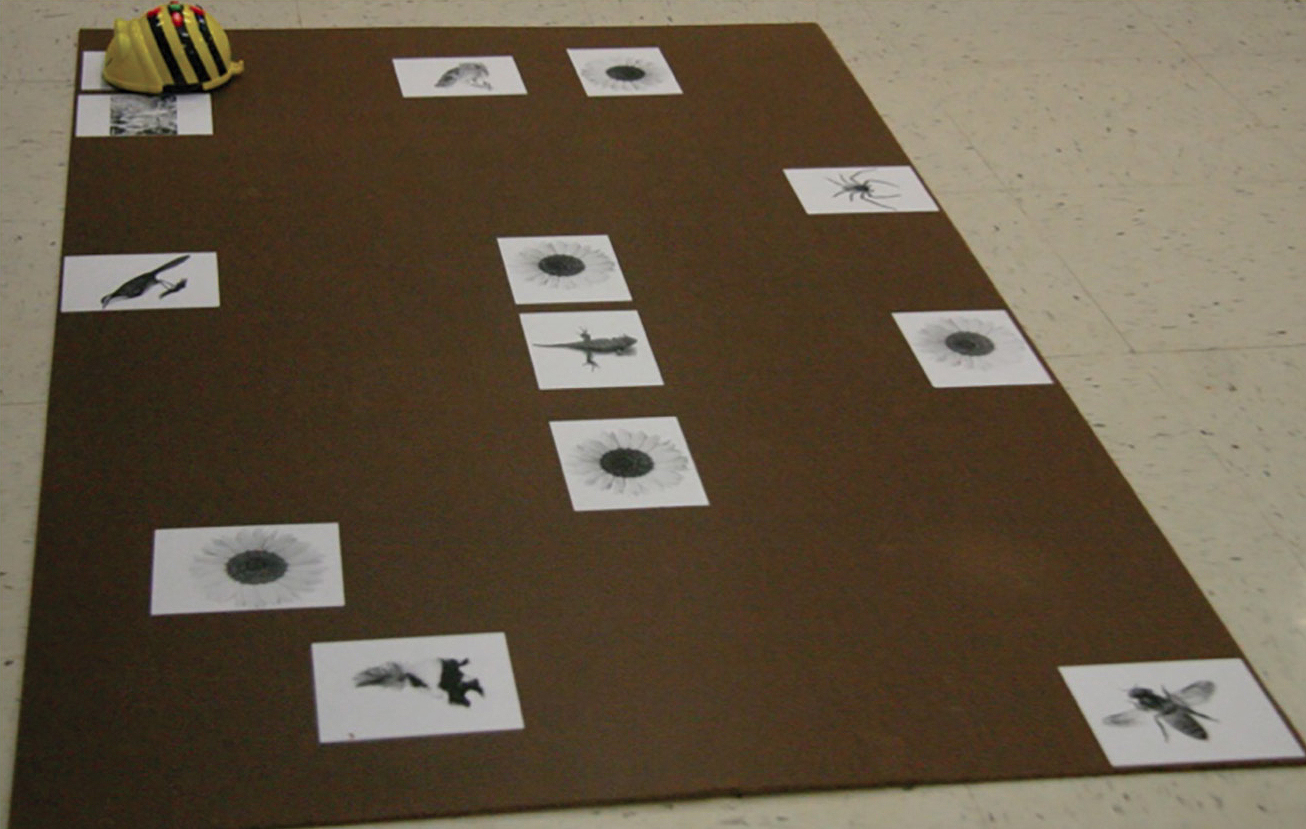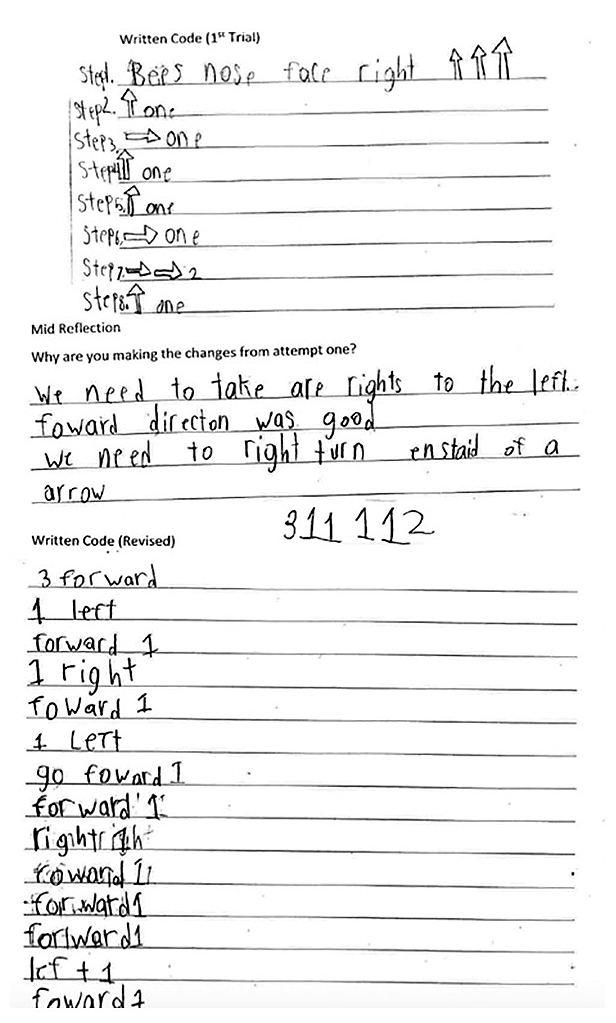cross-curricular connections
A STEAM_ed Bee
An integrated unit teaches second graders about the importance of pollination.
Science and Children—May/June 2021 (Volume 58, Issue 5)
By Katie Schrodt, Jeremy Winters, and Tracey Huddleston

The apiarist stood in front of the room as a group of 20 second graders gathered around. As she presented tasks, tools, and challenges associated with beekeeping, the second-grade students listened intently. The boys and girls cheered and playfully bantered as they learned about drones and worker bees, pollination, and honey making. The apiarist shared the struggles of collecting honey in the summer heat as well as a few encounters resulting in bee stings. In closing, she expressed the many rewards of beekeeping as well as the amazement of delicious honey! We knew the study of bees had truly made an impact with the children when a boy in the back of the group exclaimed, “Now I want to be a beekeeper!”
In today’s dynamic global economy, integrated units of study are particularly important. Students who are fluent in several disciplines and comfortable moving among them can make meaningful connections and maintain enhanced understandings (Sias et al. 2016). This article shares an integrated STEAM unit that is grounded in the science disciplinary core idea that plants depend on animals for pollination or to move their seeds around. This unit was created in an effort to teach required standards in a more integrated and meaningful fashion. Whether it was reading the latest NewsELA article or watching a National Geographic hive video on YouTube, the complex and fascinating lives of bees began to fascinate us all! Over the course of three days, a group of second-grade children explored the life of bees: What is their purpose? How do they live? Why are they important? The unit integrates three threads of learning through integrated lessons using methodology from language arts, science, math, and social studies (see Supplemental Resources). Students explore first through a language arts lesson that focuses on bees and advocacy. Next, the students think like a bee as they use math and coding to navigate a bee to do its jobs while avoiding predators. Last, the students put all of their learning together as they experience bees from the perspective of an apiarist.
Learning Thread 1: Why Does the Bee Seem Mad?
Students gathered on the carpet listening to the song “Flight of the Bumblebee” as they explored bee pictures. This served as groundwork for focusing on the essential question, Why does the bee seem mad? An interactive read-aloud experience using the anchor text What if there were no bees? by Suzanne Slade (2011) followed. The unit is built upon the core ideas presented in the text—how bees are a critical factor of the food chain and sustaining the environments in specific locations around the world. Despite their great importance, the bee population is rapidly declining greatly due to the action and inaction of human beings. So, why does the bee seem mad? Well, the bee might be mad at the widespread use of bee-killing pesticides, making collecting pollen a deadly activity; or the fact that their habitats are being lost due to human negligence and global climate change. The book discusses the importance of bees and ways to advocate for bees—to act for animals who cannot defend themselves but might be feeling a bit mad.
Three specific vocabulary words were chosen for explicit instruction: extinct, pollination, and food chain. Each of these vocabulary words were defined in kid-friendly language and given a hand motion or gesture to represent the meaning of the word. For example, the students would say “Extinct: no longer living anywhere on Earth” and they would cross their arms into a big X in front of their faces when they said the words “no longer living.” These words were chosen to drive the idea that the bees might be mad because they could be in danger of extinction, thus affecting the food chain in profound ways. Food chain was defined as a group of living things that are connected because each one eats the other. (Hand motion: Make a “bunny rabbit” with two fingers on your left hand. With the right hand make a “alligator mouth.” Using the right hand, chomp the left hand demonstrating a food chain.) Pollination was defined as the act of spreading pollen from one plant to another, so the plant is able to make more plants (Hand motion: Take your right hand and go back and forth in a “rainbow” motion to your left hand when saying “one plant to another”).
The lesson for this anchor text used an interactive read-aloud structure that embedded questions and time for discussion during reading. We practiced the strategy of “turn and talk,” explicitly teaching students how to turn to a partner and respectfully discuss a question. Each of the questions allowed the students time to think and process the text as they moved toward the answer to the questions, (1) why does the bee seem mad? and (2) what if there were no bees? For example, students were asked to notice the illustrations that imply bees are disappearing. What is the illustrator trying to communicate to us? What are you noticing now about the food chain? Why is it called a chain? See responses in Table 1.
The book was also integrated with QR codes taped into purposeful stopping points within the text. These QR codes brought students to songs, videos, and photos to enhance the text and make it multimodal. The students learned how bees use the waggle dance as an integrated geography communication tool to locate the most productive flowers and guide their companions to pollen. An interactive read-aloud should be consistently interactive, intentionally planning and allowing for lots of talk, movement, and multiple modes of learning the material.
As the culminating activity for this day, students created advocacy posters (Figure 1) that sought to bring knowledge of the importance of bees and how we can help maintain the bee population. The students were asked to distill the information from the read-aloud into six important words to be displayed on their poster, as well as add ways we can help protect bees. The students were encouraged to make their posters catch the eye of the reader. A checklist was provided for the students as they worked on their poster. They were encouraged to include each item on the checklist in their poster.
Names Title Six important words about the book / bees Advocate (what can we do to help and make others aware?) Pictures / drawings Large print for everyone to see Color
| Table 1. Student discussion examples. | ||||||||||||
|---|---|---|---|---|---|---|---|---|---|---|---|---|
|

Advocacy posters.
Learning Thread 2: Thinking like the Bee
The second thread in this integrated unit focused on the skill of coding as students “think like a bee” using Bee-Bots, programmable robots that look like bees (see Figure 2). The Bee-Bots were used as the thread to bring together the content of science, math, technology, and writing. For teachers who do not have Bee-Bots, there is a free online Bee-Bot app that could be an alternative (https://apps.apple.com/us/app/bee-bot/id500131639). Other online coding alternatives include Kodable, ScratchJr, Tynker, Hopscotch, and Lightbot. Various grants are also available for purchasing class sets of Bee-Bots or other Bots such as Ozobots.

Bee Bots
To begin the lesson, students were divided into heterogeneous pairs and given the Bee-Bots to engage in technological play. This time allowed the students to become familiar with the buttons and determine the distance of each coded move. A key learning moment during this time occurred when students would enter a code and then want to enter a second code. For example, students set up challenges for themselves in the room. After accomplishing the first challenge, they set up a second challenge. When attempting the second challenge, no groups cleared the code from the previous challenge. So, the Bee-Bot held the original code as well as the new code. This key discovery was important as the students moved into the next part of the lesson.
After this technological play time, the students reviewed what they had learned from the previous day. The two big ideas that emerged and connected to this day were predators and pollination. The students were then told they were going to continue “thinking like a bee” and attempt to program their bee to cross a premade game board. At this point, students were given the task to get the fewest points by programming the bee to get from start to finish (without leaving the board) while pollinating at least one flower and avoiding as many predators as possible in the least distance possible. (See Supplemental Materials for complete directions.)
Students were given a packet that had the task, as well as other pages for writing code and reflecting upon their work. To begin, the students were not allowed to have the Bee-Bot as they investigated the challenge. The students had the board (see Figure 3) and a meterstick. Based upon the time spent playing with the Bee-Bot, the students knew the Bee-Bot traveled a distance of roughly 150 mm per move forward. Students used the metersticks to plot a path to complete the task. After some time was given for groups to plan their paths, they were instructed to write the code for their Bee-Bot (see Figure 4). Students were able to see the Bee-Bot buttons, but they were still not allowed to program the bee. Students were instructed to be precise in the code so that if someone else was reading the code, they would be able to program the Bee-Bot in the exact same way.

Game board.

Coding Instructions
Next, the students coded the Bee-Bot based upon their written code. As the excitement in the room rose, both cheers and moans could be heard. Students were asked to reflect upon their initial thinking and written code. One student wrote, “We need to take our rights to the left.” Other groups commented this as well as they intended the Bee-Bot to go one direction based upon its starting orientation rather than where it was oriented at the time. Based upon these reflections, students were able to re-code the Bee-Bot. Once again students were asked to be precise in their written code so that anyone else would be able to code the Bee the same way. After this second attempt, all the groups cheered!
After the cheers subsided, groups were told to leave their codes at their boards and rotate to the board next to them. Their job now was to critique the code that was left by another group. All groups had difficulty with the code that the previous group had left behind. Why? Because the previous groups first command was to move forward one move. As critics, the group began to question which direction the Bee-Bot should face. Initially some groups had this step in their code. For example, one group wrote, “Step 1. Bee’s nose face right,” but in the rewrite the group did not include this step. So, all groups had to tell the critiquing group how to orient the Bee-Bot to begin. After this initial issue, most groups were able to program the Bee-Bot as the group intended. Some constructive feedback was left by the critics who were at boards where the code did not work.
The final step for this day was to take the feedback from other groups and make final changes if needed. Students were to do a final program of the Bee-Bot and determine how many points their group earned based on the points rubric sheet. Points were added for every move forward (150 points per move) and every Predator hit (100 points per predator), while points were subtracted for flowers pollinated (50 points per flower). Remember, the task was to get the fewest number of points. Groups utilized a variety of methods to determine the number of points they earned. All groups were successful in determining groups points, although this did take some time. In the end, all groups (except one) had achieved the minimum number of points—1,500. The one exception did code the Bee-Bot to the finish, but hit a predator along the way, thus increasing the number of points. The task followed an intentional pattern of exploration, group work, seeking and giving feedback, and retries. This pattern allowed for differentiation and success for the students.
While concluding the lesson, the students were able to share multiple things they had learned by engaging in the thread of the Bee-Bot: knowing about predators of bee, the function of pollination, adding and subtracting by thinking about 50s and 100s, and the purpose of “how to” writing and its connection to coding. Moreover, we saw students engaged in critical thinking and problem-solving throughout the lesson. The students embraced the productive struggle that came with doing a challenging but rewarding task.
Learning Thread 3: Buzzing all Around
A local professional apiarist visited to share fascinating information regarding different types of bees, their specific jobs within the hive, their life spans, and how quickly they produce honey. The apiarist also brought in actual tools needed to tend the bees, as well as the protective suit for students to try on. A “frame” protected by glass allowed the students to observe real bees working as the apiarist explained the various personalities of the bees, how they react to the cold weather, and how the bees interact with the queen bee. If live animals are not an option, a webcam is a great alternative. Students who are allergic should be provided with options for alternative assignments. Live bee cams can be found here: https://explore.org/livecams/honey-bees/honey-bee-hive-cam.
To further investigate information learned from the apiarist, students interacted with five separate learning stations: Tessellations, Pollination, Centrifugal Force, Parts of a Bee, and Compare/Contrast Bees with Wasps. Students were intentionally divided into heterogenous groups of two to four. Those students who needed more focused work were placed in smaller groups. Each station was interactive, and students were there for approximately 15 minutes to keep the learning active and moving.
In the Tessellation Station, students used Polydrons to understand the term tessellation and design their own model of a honeycomb using the Polydron manipulatives. In the Pollination Station, students learned the significant number of plants that are dependent upon the pollination of bees. Students built tacos and pizzas and then discussed what ingredients would not be possible without the pollination of bees. While at the Centrifugal Force Station, students observed a marble spin around a drinking glass as a model for how honey is extracted from the comb. The apiarist showed a video of honey being extracted from the hive in her own kitchen (https://youtu.be/N4j9Qf8bQiE).
At the “Parts of the Bee” station, students observed and discussed specific parts of bee anatomy. Using a poster-size model, students were able to label the parts on the model using Velcro. The parts of the bee included the antennae, eyes, legs, thorax, abdomen, wings, pollen basket on back leg, and stinger. The last station was Comparing/Contrasting Bees with Wasps. Since these two insects are often confused and very different, this is an important concept to include in the study. Students used a life-size Venn diagram to learn the distinct differences between the two species.
The ultimate goal of this section was to allow opportunity for the students to get to know bees on a more intimate level, to begin to understand them as more than stinging insects we should run away from. So, why does the bee seem mad? Maybe because human beings do not fully understand the importance of a bee’s job. After this unit, we hoped to create a deeper connection to bees and their significant purpose in our world and therefore encourage students to advocate for bees and our environment.
Making Connections
This three-day unit included traditional summative assessment as well as three integrated formative assessments throughout. Traditional pre- and post-tests were given to the students at the beginning and ending of this integrated unit. This traditional assessment was used as a pre- and post- for evaluating the increase in bee understandings rather than scored to evaluate students’ summative assessment. The formative assessments throughout as well as the final question on the assessment are the most important for gathering the big ideas for what the students learned.
Students increased on their scores across the unit, but more importantly, they increased in their integrated understanding of bees. Rather than just talking about honey and pollen, students wrote about the interconnectedness of plants, bees, the environment, and humans. In closing, one student cleverly said of bees, “If we didn’t have them, we wouldn’t BEE alive.”
Supplemental Resources
Download the Flight of the Bumblebee instructions at https://bit.ly/3dH3QLJ, Standards connections at https://bit.ly/32AHJQy, and assessment at https://bit.ly/32KpQyF.
Katie Schrodt (katie.schrodt@mtsu.edu) is an assistant professor, and Jeremy Winters and Tracey Huddleston are professors, all at Middle Tennessee State University in Murfreesboro, Tennessee.
Computer Science Engineering Interdisciplinary STEM Teaching Strategies Technology


